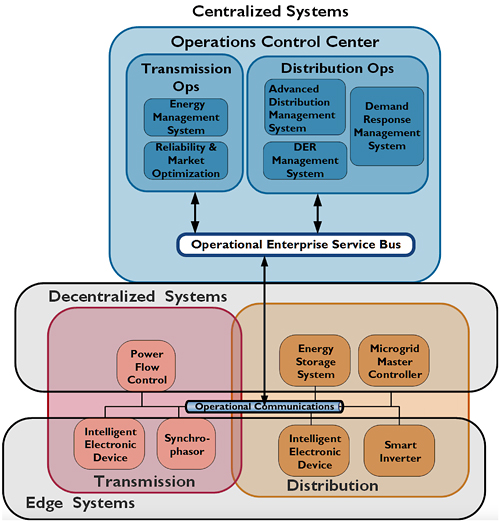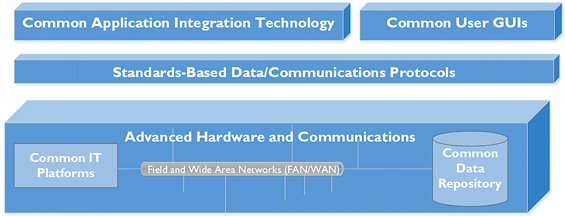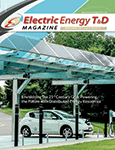Distribution and Transmissions systems are evolving to accommodate increasing amounts of renewable distributed generation (DG) while also dealing with more intense storms, cyber security threats, evolving markets and aging infrastructure. Adapting to these changes requires necessary adjustments to protection schemes, fault detection, outage management, market interfaces, grid topologies, and a host of other considerations.
At the same time, advances in communications as well as intelligent grid monitoring and control devices have created tremendous amounts of data reporting details of current grid conditions. Available data can provide operational insight and enable control systems to manage the complexities of two-way power flows, the intermittent nature of wind and solar generation while also better managing storms and proactively identifying equipment which needs to be replaced. Proper management and analysis of available data can provide situational awareness enabling utilities to respond to increasingly dynamic load profiles as well as reverse power flows.
The question is how to incorporate planned and existing T&D equipment, sensors, intelligent control devices and communications systems to effectively integrate DERs, improve reliability, and better manage aging assets. Effective implementation of both an enterprise architecture and a data management strategy can enable the modernization of T&D systems necessary to address the many challenges currently facing electric utilities. This article begins with the rationales for enterprise architecture and a data management strategy, and then presents a solution approach to systematically implement a modern grid.
Historically, power flowed from bulk generation sources to consumers, with baseload generation, peak generation and ancillary services ensuring that energy demands were met. Generation and transmission systems were centrally managed while distribution systems required little active control. The voltage and frequency deadband was large enough to accommodate the small amount of DG that was installed on the distribution system.
Today in increasing portions of the grid these assumptions are no longer valid and with further disruptions possible because of future unknown market mechanisms and future technological changes, more flexible systems are needed. In particular, a system of systems (SoS) architecture featuring distributed and edge controls is needed as well as an effective data management strategy.
As shown, enterprise architecture with new and existing centralized control systems such as Advanced Distribution Management Systems (ADMS) and Distributed Energy Resources (DER) management systems can address increasing dynamic conditions on distribution systems.

Decentralized and edge control systems including field message buses (FMB), intelligent electronic devices (IEDs), smart inverters and energy storage systems can meet timing requirements and reduce the communications bandwidth required for centralized controls. Decentralized and edge control systems efficiently monitor and manage assets leveraging three fundamental advantages. First, edge and decentralized controls can react much more quickly than centralized systems which have a built-in communications delay. Secondly the large number of new devices makes centralized control unwieldly.
For example, with utilities now reporting hundreds of thousands of DERs, centralized control, especially if human operators are needed, is simply not possible even if the necessary communications bandwidth were available. Third, delegating controls such as DER schedules to distributed and edge devices allows for data analysis and management to be distributed to many devices. Doing so reduces the need for large complex centralized systems and large-bandwidth communications networks. Decentralized and edge devices can make decisions using local data based on pre-determined parameters, sending overall results to centralized systems which can then optimize the overall T&D systems.
Distributed and edge controls are both necessary and feasible. For example, edge controls such as smart inverters attached to DG and distributed controls such as community energy storage systems can provide real time control of voltage and reactive power on distribution circuits. Centralized systems can then perform state estimate calculations based on received data.
An architecture using edge, decentralized and centralized processing is an enabling technology necessary to utilize the vast qualities of available data. In addition, data analysis capabilities and data management strategies are needed to leverage the data from sensors and intelligent devices. Data management capabilities include time alignment, operational analysis, data mining and data analytics.
Time alignment is the process of time syncing data points as well as techniques to filter data when too many data points are received and techniques to estimate data points when too little valid data is received.
Operational analysis is the process of integrating raw data from multiple sources into meaningful knowledge. Data fusion transforms raw data into situational assessments, impact assessments and recommended improvements to sensor settings.
Data mining identifies patterns in data using statistics and advanced techniques. It is used to identify factors relevant to outcomes of interest. For example, data mining can be used to identify sensor readings indicating a high probability of an asset failing.
Data analytics will allow the vast amount of data available to be leveraged and effectively applied to address the challenges facing today’s grid control systems. Data analysis includes advanced techniques such as machine learning.
Realizing that decentralized control and data techniques can improve and optimize today’s increasingly complex T&D systems is the first step in architecting future grid systems. The next step is to define the solutions needed to implement the modernized grid systems. For generation, transmission and distribution utilities, architecture building blocks can be used to transform existing systems into future grid systems which address many challenges including business model challenges, increasing severe storms, aging infrastructure and uncertain future markets.
As shown below, enterprise architecture building blocks highlight implementation of the decentralized processing and data management strategy. At the base are hardware based solutions including common IT platforms typically with multiple processors, storage area networks (SANs), firewalls and other cyber security products. Other base solutions are common data repositories and Field or Wide Area Networks (WANs) which are typically based on dual IPv4 and IPv6 protocols. Mid-level architecture blocks include standards-based data models, typically IEC 61850, standard communications protocols such as DNPv3 and standard message formats such as MultiSpeak. Standards-based communications protocols and message formats are a key enabling technology for the Internet of Things (IoT), for devices such as cellular phones, and for apps which run on many types of devices. Using standards-based communications technology will help enable faster implementation of modern grids.
The next level of architecture blocks are application integration technologies including web-based Application Programming Interfaces (APIs) and Graphical User Interfaces (GUIs) with a common look and feel for all applications.

Architecture Building Blocks
After defining architecture building blocks, the next step is to define common architecture details for operational systems. This step defines communications, data and application specific solutions such as IEC-61850 based profiles and web-based service interface definitions, integrated firewalls/intrusion detection and prevention systems, and protocol translators for communicating with legacy equipment.
Adaption of enterprise architecture using the steps outlined here can be used to integrate increasingly large numbers of DGs, improve operational efficiency and adapt to new markets using data analysis and management techniques, standardized data definitions/protocols and cyber secure communications.
About the Author
 Kay Stefferud is Director of Implementation Services for EnerNex. She is a collaborative, versatile and results-oriented system engineer, who has 30 years of technical, program and team leadership experience in dynamic, rapidly-evolving environments. She uses her analytical problem solving skills in architecture development, requirements specification, procurement, design, test and system deployment. Kay has full project experience from concept development to system installation and training. Kay’s projects include specifying, designing, and testing microgrids, assessing the impacts of distributed energy resources including solar PV systems, and developing enterprise architectures and innovative energy solutions.
Kay Stefferud is Director of Implementation Services for EnerNex. She is a collaborative, versatile and results-oriented system engineer, who has 30 years of technical, program and team leadership experience in dynamic, rapidly-evolving environments. She uses her analytical problem solving skills in architecture development, requirements specification, procurement, design, test and system deployment. Kay has full project experience from concept development to system installation and training. Kay’s projects include specifying, designing, and testing microgrids, assessing the impacts of distributed energy resources including solar PV systems, and developing enterprise architectures and innovative energy solutions.








